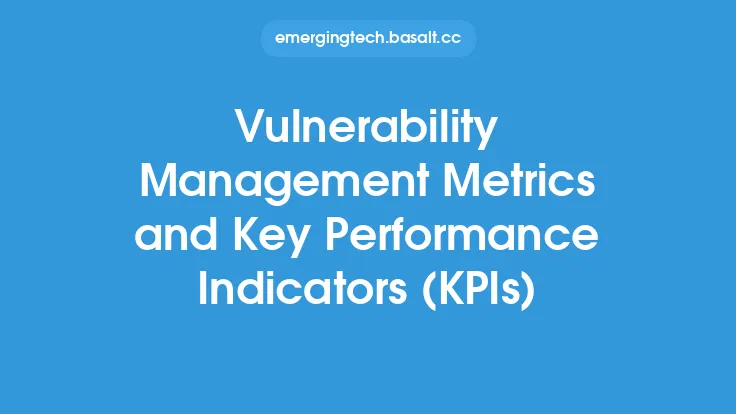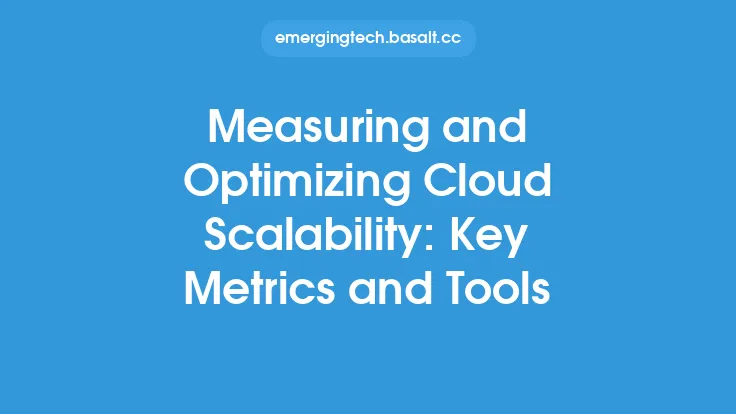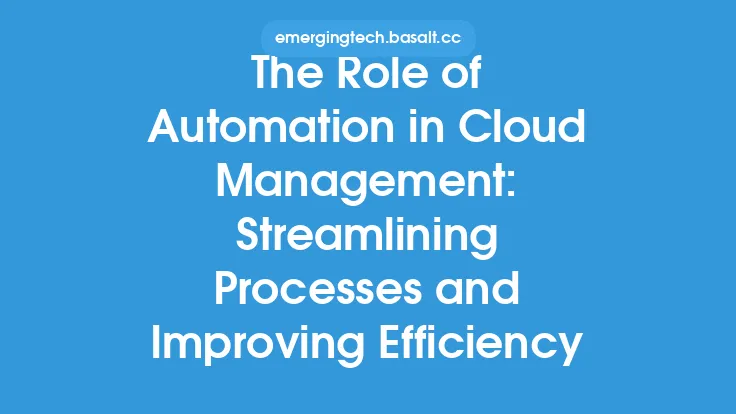To effectively measure the success of cloud management, it's essential to establish a set of key performance indicators (KPIs) and metrics that provide insight into the performance, efficiency, and cost-effectiveness of cloud resources. These metrics serve as a benchmark for evaluating the success of cloud management strategies and identifying areas for improvement. In this article, we'll delve into the most critical KPIs and metrics for measuring cloud management success, providing a comprehensive understanding of how to assess and optimize cloud performance.
Introduction to Cloud Management Metrics
Cloud management metrics are designed to measure the performance, security, and cost-effectiveness of cloud resources. These metrics can be categorized into several groups, including performance metrics, security metrics, cost metrics, and compliance metrics. By tracking these metrics, organizations can gain a deeper understanding of their cloud environment and make data-driven decisions to optimize their cloud management strategy. Some common cloud management metrics include cloud resource utilization, cloud storage capacity, network latency, and security incident response time.
Key Performance Indicators for Cloud Management
KPIs are quantifiable measures used to evaluate the success of an organization's cloud management strategy. Some essential KPIs for cloud management include:
- Cloud resource utilization: This KPI measures the percentage of cloud resources being utilized, helping organizations identify underutilized or overutilized resources.
- Cloud cost optimization: This KPI tracks the cost-effectiveness of cloud resources, ensuring that organizations are getting the best value for their cloud spend.
- Cloud security posture: This KPI evaluates the security of cloud resources, including the number of security incidents, vulnerability patches, and compliance with security policies.
- Cloud performance: This KPI measures the performance of cloud resources, including latency, throughput, and uptime.
- Cloud compliance: This KPI ensures that cloud resources are compliant with regulatory requirements, industry standards, and organizational policies.
Cloud Management Metrics for Cost Optimization
Cost optimization is a critical aspect of cloud management, as it directly impacts an organization's bottom line. Some key metrics for cost optimization include:
- Cloud spend: This metric tracks the total cost of cloud resources, including compute, storage, and network costs.
- Cloud resource utilization: This metric measures the utilization of cloud resources, helping organizations identify opportunities to right-size resources and reduce waste.
- Reserved instance utilization: This metric tracks the utilization of reserved instances, which can provide significant cost savings for organizations with predictable workloads.
- Cloud storage costs: This metric measures the cost of cloud storage, including the cost of data storage, data transfer, and data retrieval.
Cloud Management Metrics for Security and Compliance
Security and compliance are critical aspects of cloud management, as they directly impact an organization's risk posture and reputation. Some key metrics for security and compliance include:
- Security incident response time: This metric measures the time it takes to respond to security incidents, including the time to detect, contain, and remediate incidents.
- Vulnerability patching: This metric tracks the number of vulnerabilities patched, including the time to patch and the percentage of patched vulnerabilities.
- Compliance with security policies: This metric evaluates the compliance of cloud resources with security policies, including the number of policy violations and the time to remediate violations.
- Data encryption: This metric measures the percentage of data encrypted, including data at rest and data in transit.
Cloud Management Metrics for Performance and Availability
Performance and availability are critical aspects of cloud management, as they directly impact an organization's ability to deliver services to customers. Some key metrics for performance and availability include:
- Uptime: This metric measures the percentage of time that cloud resources are available, including the time to recover from outages.
- Latency: This metric measures the time it takes for cloud resources to respond to requests, including the time to process requests and return responses.
- Throughput: This metric measures the amount of data that can be processed by cloud resources, including the number of requests per second and the amount of data transferred per second.
- Error rates: This metric measures the number of errors encountered by cloud resources, including the number of error messages and the time to resolve errors.
Best Practices for Measuring Cloud Management Success
To effectively measure cloud management success, organizations should follow several best practices, including:
- Establish clear goals and objectives: Organizations should establish clear goals and objectives for cloud management, including specific KPIs and metrics to track.
- Monitor and report on KPIs: Organizations should monitor and report on KPIs regularly, including daily, weekly, and monthly reports.
- Use automation: Organizations should use automation to collect and analyze data, including the use of cloud management platforms and tools.
- Continuously improve: Organizations should continuously improve their cloud management strategy, including the use of data-driven decision making and the implementation of new technologies and processes.
Conclusion
Measuring cloud management success is critical to ensuring the effective use of cloud resources. By establishing a set of KPIs and metrics, organizations can gain a deeper understanding of their cloud environment and make data-driven decisions to optimize their cloud management strategy. Some essential KPIs and metrics for cloud management include cloud resource utilization, cloud cost optimization, cloud security posture, cloud performance, and cloud compliance. By following best practices for measuring cloud management success, organizations can ensure the effective use of cloud resources and achieve their business objectives.





